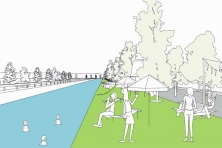The Sleeping Beauty
Workshop Pavia (IT) - "Adaptable Campus-City" - Workshop Site 2
PARTICIPANTS:
Julien Boidot (FR), Arnaud Ledu (FR), Mathieu Holdrinet (FR), Winner in Fosses (FR) with "L'amateur"
Pieter Delacourt (BE), Ton van Beek (NL), Runner-up in Groningen (NL) with "Uploading City "
Thomas Nouaillier (FR), Winner in Paris-Saclay (FR) with "Lieu(x) de négociation(s)"
Coach: Benrd Vlay (AT)
Assistants: Matteo Locatelli (IT)
SITE 2 - THE NAVIGLIO: A CHANCE OF COEXISTENCE BETWEEN STUDENTS AND CITIZENS
Large-scale infrastructures are not only the primary condition to network a territory through a system of links. More and more infrastructures have converted to important spatial spheres for different kind of activities and programs. Being part of the historical Lombardian system of naviglios (i.e. canals), the Naviglio Pavese represents an outstanding infrastructural project that provides the perfect example for testing modes of adaptability through which this infrastructure can become a space that fundamentally transforms the meaning and performance of a city, or even a region. The territorial scale of the Naviglio Pavese clearly provokes the tension between regional logics and local impacts. This unavoidable ambiguity becomes productive if we consider the context of recent urban transformations in times of shrinking resources. The disappearance of large-scale production complexes in city areas, the growing importance of sustainable and more efficient mobility-systems, new models of civic initiatives and the increasingly dominant role of nature and public landscape as identifying elements give waterline infrastructures such as the Naviglio the potential to fundamentally change urban conditions, which is a central concern among young architects.
The results of the Pavia workshop addresses this concern in very specific ways: “Gran Pavia – the Territorial Campus” focuses on the added value through local and regional cross-programming; “Ride & Park” reveals the extraordinary potentials of change that can be triggered by a more sustainable concept of mobility; “The Sleeping Beauty” suggests a new geography of sharing across the boundary of the Naviglio through a radical intervention in the university heritage of the city.
The Sleeping Beauty
Download the PDF here

The reuse of the existing heritage is one of the most mandatory and at the same time most radical topics of the adaptable city’s agenda. “The Sleeping Beauty” provokes a fruitful encounter between local heritage and international concerns on how to address the heritage potential. Promoting an “urbanism by feet” (B. Secchi), which takes advantage from direct visits of people, situations and physical elements, the team was able to discover a hidden desire for a better integration of students life in the city’s neighbourhoods. The project therefore suggests a radical manoeuvre of reuse: the reintegration (and dissolution!) of the displaced university campus “Cravino“ in midst the existing structure of the town, fragmenting productively its institutes and departments in different disctricts and buildings, new or existing. Some of them can be located in the carefully chosen, southern area of the Naviglio. Through this spatial operation the university shall convert into an urban ecosystem that enables new “care economies“ and productive modes of sharing between different generations of citizens. Surprising options for social cohesiveness become the driving force for a substantial urban transformation.
Download the PDF here


See other projects on the same site:
See the other sites:
- Creating an Inter-Campus Dynamic Axis
- Sharing the Ticino River: Sports and Leisure

